Microstructural, Mechanical and Oxidation Resistance of Nanolayer Sputter-Deposited CrAlN Hard Coatings
Abstract
:1. Introduction
2. Materials and Methods
2.1. Coating Deposition
2.2. Coating Characterization
3. Results
3.1. Characterization of As-Deposited (Cr,Al)N Nanolayer Coatings
3.1.1. Coating Composition
3.1.2. Coating Thickness
3.1.3. Coating Hardness
3.1.4. Surface Topography and Microstructure of (Cr,Al)N Nanolayer Coatings
3.1.5. Crystal Structure
3.2. Characterization of Oxidized (Cr,Al)N Coatings
3.2.1. Crystal Structure
3.2.2. Weight Gain Measurements of the Oxidized Coatings
3.2.3. SEM and TEM Analysis of the Oxidized Coatings
4. Conclusions
- We showed that by using triangle-like segmented targets for an industrial-scale magnetron deposition system, a series of hard coatings with different compositions and modulation periods in one batch can be prepared; this approach greatly shortens and simplifies the development of a new multicomponent hard coating.
- Sputter-deposited nanolayer (Cr,Al)N hard coatings with Al/Cr atomic ratios in the range of 0.27 to 1.3 exhibit fcc cubic structure, which is typical of transition metal nitrides. Only in the case of a high atomic ratio (Al/Cr = 1.3), is the h-AlN phase also detected.
- During high-temperature oxidation, a protective dense chromium oxide scale is formed on the top of the oxide scale. The oxide layer thickness increased, following a parabolic-type growth, with an activation energy of 3.06 eV for the Al-rich (Cr,Al)N coatings and 1.81 eV for Cr-rich ones. The thickness of the oxide layer depends on the Al/Cr atomic ratio; it is largest for the Cr-rich layer and smallest for the Al-rich one.
- The structure of the oxidation scales depends on the Al/Cr atomic ratio: for Al-rich coatings, the oxidation scales consisted of both a Cr-O outside layer and a mixed (Cr,Al)-oxide inner layer, while only a Cr-O layer was observed for Cr-rich coatings.
- A dense Cr-based oxide scale acted as a barrier layer, blocking the outward diffusion of metallic atoms and retarding the inward diffusion of oxygen into the coating.
- We found that the oxidation of the substrate occurs at the growth defect sites at a temperature which is well below the temperature for the initiation of the (Cr,Al)N coating oxidation. The oxidation process at the sites of defects largely depends on the type of substrate material.
Author Contributions
Funding
Institutional Review Board Statement
Informed Consent Statement
Data Availability Statement
Acknowledgments
Conflicts of Interest
References
- Vetter, J.; Eriksson, A.O.; Reiter, A.; Deflinger, V.; Kalss, W. Quo Vadis: AlCr-Based Coatings in Industrial Applications. Coatings 2021, 11, 344. [Google Scholar] [CrossRef]
- Tillman, W.; Dias, N.F.L.; Stangier, D. Effect of Hf on the microstructure, mechanical properties, and oxidation behavior of sputtered CrAlN films. Vacuum 2018, 154, 208–213. [Google Scholar] [CrossRef]
- Knotek, O.; Atzor, M.; Barimani, C.; Jungblut, F. Development of low temperature ternary coatings for high wear resistance. Surf. Coat. Technol. 1990, 42, 21–28. [Google Scholar] [CrossRef]
- Hoffmann, S.; Jehn, H.A. Oxidation behaviour of CrNx and (Cr,Al)N hard coatings. Werkst. Korros. 1990, 47, 756–760. [Google Scholar] [CrossRef]
- Gerth, J.; Larsson, M.; Wiklund, U.; Riddar, F.; Hogmark, S. On the wear of PVD-coated HSS hobs in dry gear cutting. Wear 2009, 266, 444–452. [Google Scholar] [CrossRef]
- Kalss, W.; Reiter, A.; Derflinger, V.; Gey, C.; Endrino, J.L. Modern coatings in high performance cutting applications. Int. J. Refract. Met. Hard Mater. 2006, 24, 399–404. [Google Scholar] [CrossRef]
- Lugscheider, E.; Bobzin, K.; Hornig, T.; Maes, M. Investigation of the residual stresses and mechanical properties of (Cr,Al)N arc PVD coatings used for semi-solid metal (SSM) forming dies. Thin Solid. Film. 2002, 420-421, 318–323. [Google Scholar] [CrossRef]
- Bobzin, K.; Bagcivan, N.; Goebbels, N.; Yilmaz, K.; Hoehn, B.R.; Michaelis, K.; Hochmann, M. Lubricated PVD CrAlN and WC/C coatings for automotive applications. Surf. Coat. Technol. 2009, 204, 1097–1101. [Google Scholar] [CrossRef]
- Bobzin, K.; Brögelmann, T.; Kalscheuer, C.; Liang, T. High-rate deposition of thick (Cr,Al)ON coatings by high speed physical vapor deposition. Surf. Coat. Technol. 2017, 322, 152–162. [Google Scholar] [CrossRef]
- Vetter, J.; Lugscheider, E.; Guerreiro, S.S. (Cr:Al)N coatings deposited by the cathodic vacuum are evaporation. Surf. Coat. Technol. 1998, 98, 1233–1239. [Google Scholar] [CrossRef]
- Kawate, M.; Hashimoto, A.K.; Suzuki, T. Oxidation resistance of Cr1−xAlxN and Ti1−xAlxN films. Surf. Coat. Technol. 2003, 165, 163–167. [Google Scholar] [CrossRef]
- Lin, J.; Mishra, B.; Moore, J.J.; Sproul, W.D. A study of the oxidation behavior of CrN and CrAlN thin films in air using DSC and TGA analyses. Surf. Coat. Technol. 2008, 202, 3272–3283. [Google Scholar] [CrossRef]
- Mayrhofer, P.H.; Rachbauer, R.; Holec, D.; Rovere, F.; Schneider, J.M. Protective Transition Metal Nitride Coatings. In Comprehensive Materials Processing; Newnes: Newton, MA, USA, 2014; pp. 355–388. [Google Scholar]
- Willmann, H.; Mayrhofer, P.H.; Persson, P.H.A.; Reiter, A.E.; Hultman, L.; Mitterer, C. Thermal stability of Al–Cr–N hard coatings. Scr. Mater. 2006, 54, 1847–1851. [Google Scholar] [CrossRef]
- Lin-qing, H.; Chen, L.; Xu, Y.-X.; Du, Y. Thermal stability and oxidation resistance of Cr1−xAlxN coatings with single phase cubic structure. J. Vac. Sci. Technol. A 2015, 33, 061513. [Google Scholar]
- Liu, C.B.; Pei, W.; Huang, F.; Chen, L. Improved mechanical and thermal properties of CrAlN coatings by Si solid solution. Vacuum 2016, 125, 180–184. [Google Scholar] [CrossRef]
- Polcar, T.; Cavaleiro, A. High temperature properties of CrAlN, CrAlSiN and AlCrSiN coatings—Structure and oxidation. Mater. Chem. Phys. 2011, 129, 195–201. [Google Scholar] [CrossRef]
- Drnovšek, A.; de Figueiredo, R.M.; Vo, H.; Xia, A.; Vachhani, S.J.; Kolozsvári, S.; Hosemann, P.; Franz, R. Correlating high temperature mechanical and tribological properties of CrAlN and CrAlSiN hard coatings. Surf. Coat. Technol. 2019, 372, 361–368. [Google Scholar] [CrossRef]
- Hu, C.; Chen, L.; Lou, Y.; Zhao, N.; Yue, J. Influence of Si content on the microstructure, thermal stability and oxidation resistance of TiAlSiN/CrAlN multilayers. J. Alloys Compd. 2021, 855, 157441. [Google Scholar] [CrossRef]
- Bobzin, K.; Bagcivan, N.; Immich, P.; Bolz, S.; Cremer, R.; Leyendecker, T. Mechanical properties and oxidation behaviour of (Al,Cr)N and (Al,Cr,Si)N coatings for cutting tools deposited by HPPMS. Thin Solid. Film. 2008, 517, 1251–1256. [Google Scholar] [CrossRef]
- Tian, J.L.; Hu, C.; Chen, L.; Lou, Y.M.; Zhao, N.N. Structure, mechanical and thermal properties of Y-doped CrAlN coatings. Trans. Nonferrous Met. Soc. China 2021, 31, 2740–2749. [Google Scholar] [CrossRef]
- Rovere, F.; Mayrhofer, P.H. Thermal stability and thermo-mechanical properties of magnetron sputtered Cr-Al-Y-N coatings. J. Vac. Sci. Technol. A 2007, 26, 29–35. [Google Scholar] [CrossRef]
- Chen, L.; Liu, Z.Q.; Xu, Y.X.; Du, Y. Influence of Zr on structure, mechanical and thermal properties of CrAlN coatings. Surf. Coating. Technol. 2015, 275, 289–295. [Google Scholar] [CrossRef]
- Forsén, R.; Johansson, M.P.; Odén, M.; Ghafoor, N. Effects of Ti alloying of AlCrN coatings on thermal stability and oxidation resistance. Thin Solid. Films 2013, 534, 394–402. [Google Scholar] [CrossRef]
- Chun, H.; Yu, X.; Chen, L.; Pei, F.; Zhang, L.J.; Du, Y. Structural, mechanical and thermal properties of CrAlNbN coatings. Surf. Coat. Technol. 2018, 349, 894–900. [Google Scholar]
- Chun, H.; Yu-Xiang, X.; Li, C.; Fei, P.; Yong, D. Mechanical properties, thermal stability and oxidation resistance of Ta-doped CrAlN coatings. Surf. Coat. Technol. 2019, 368, 25–32. [Google Scholar]
- Tillmann, W.; Kokalj, D.; Stangier, D.; Paulus, M.; Sternemann, C.; Tolan, M. Investigation on the oxidation behavior of AlCrVxN thin films by means of synchrotron radiation and influence on the high temperature friction. Appl. Surf. Sci. 2018, 427, 511–521. [Google Scholar] [CrossRef]
- Hu, C.; Chen, L.; Moraes, V. Structure, mechanical properties, thermal stability and oxidation resistance of arc evaporated CrAlBN coatings. Surf. Coat. Technol. 2021, 417, 127191. [Google Scholar] [CrossRef]
- Bagcivan, N.; Bobzin, K.; Theiß, S. (Cr1−xAlx)N: A comparison of direct current, middle frequency pulsed and high power pulsed magnetron sputtering for injection molding components. Thin Solid. Film. 2013, 528, 180–186. [Google Scholar] [CrossRef]
- Panjan, P.; Drnovšek, A.; Dražić, G. Influence of Growth Defects on the Oxidation Resistance of Sputter-Deposited TiAlN Hard Coatings. Coatings 2021, 11, 123. [Google Scholar] [CrossRef]
- Terek, P.; Kukuruzović, D.; Kovačević, L.; Miletić, A.; Terek, V.; Škorić, B.; Panjan, P.; Čekada, M. The Influence of CrAlN Coating Chemical Composition on Soldering Resistance in Contact with Al-Si-Cu Alloy. Mater. Proc. 2020, 2, 28. [Google Scholar]
- Andersen, H.H.; Bay, H.L. Sputtering by Particle Bombardment, 1st ed.; Behrisch, R., Ed.; Springer-Verlag: New York, NY, USA, 1981; pp. 145–218. [Google Scholar]
- Mahne, N.; Čekada, M.; Panjan, M. Total and Differential Sputtering Yields Explored by SRIM Simulations. Coatings 2022, 12, 1541. [Google Scholar] [CrossRef]
- Mayrhofer, P.H.; Music, D.; Reeswinkel, T.; Fuß, H.-G.; Schneider, J.M. Structure, elastic properties and phase stability of Cr1–xAlxN. Acta Mater. 2008, 56, 2469–2475. [Google Scholar] [CrossRef]
- Waseda, Y.; Matsubara, E.; Shinoda, K. ; X-ray Diffraction Crystallography; Springer: New York, NY, USA, 2011; Chapter 4; pp. 120–121, 145–152. [Google Scholar]
- Williamson, G.K.; Hall, W.H. X-ray line broadening from filed aluminium and wolfram. Acta Metall. 1953, 1, 22–31. [Google Scholar] [CrossRef]
- Rojas, T.C.; Domínguez-Meister, S.; Brizuela, M.; Sánchez-López, J.C. High-temperature oxidation of CrAlYN coatings: Implications of the presence of Y and type of steel. Surf. Coat. Technol. 2018, 354, 203–213. [Google Scholar] [CrossRef]

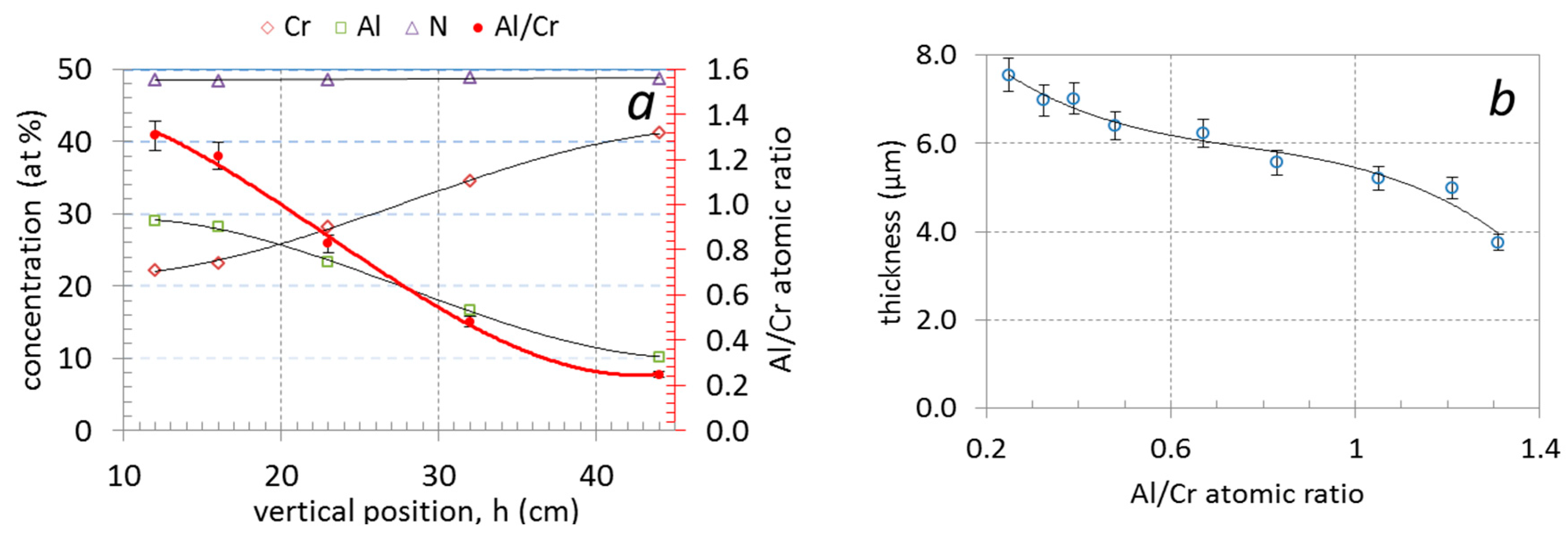


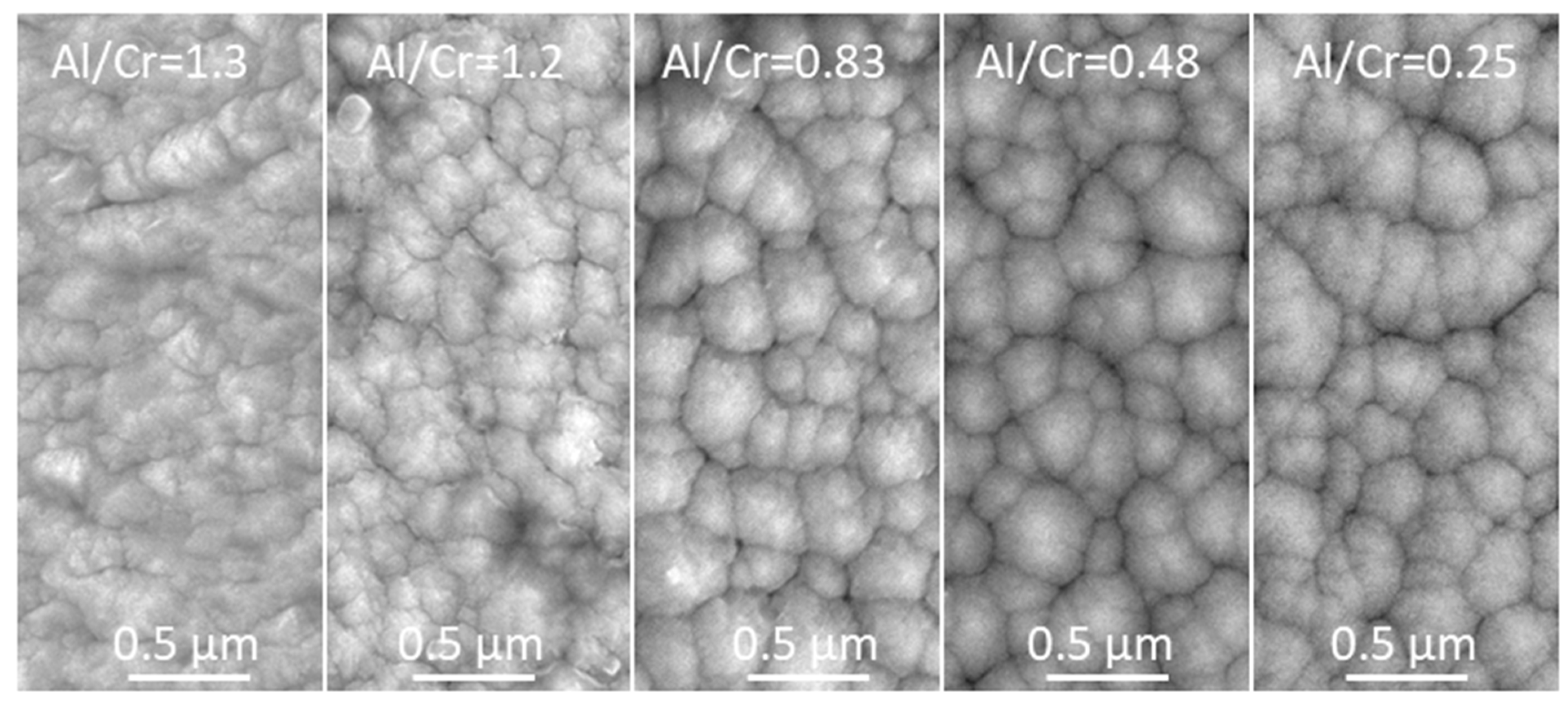
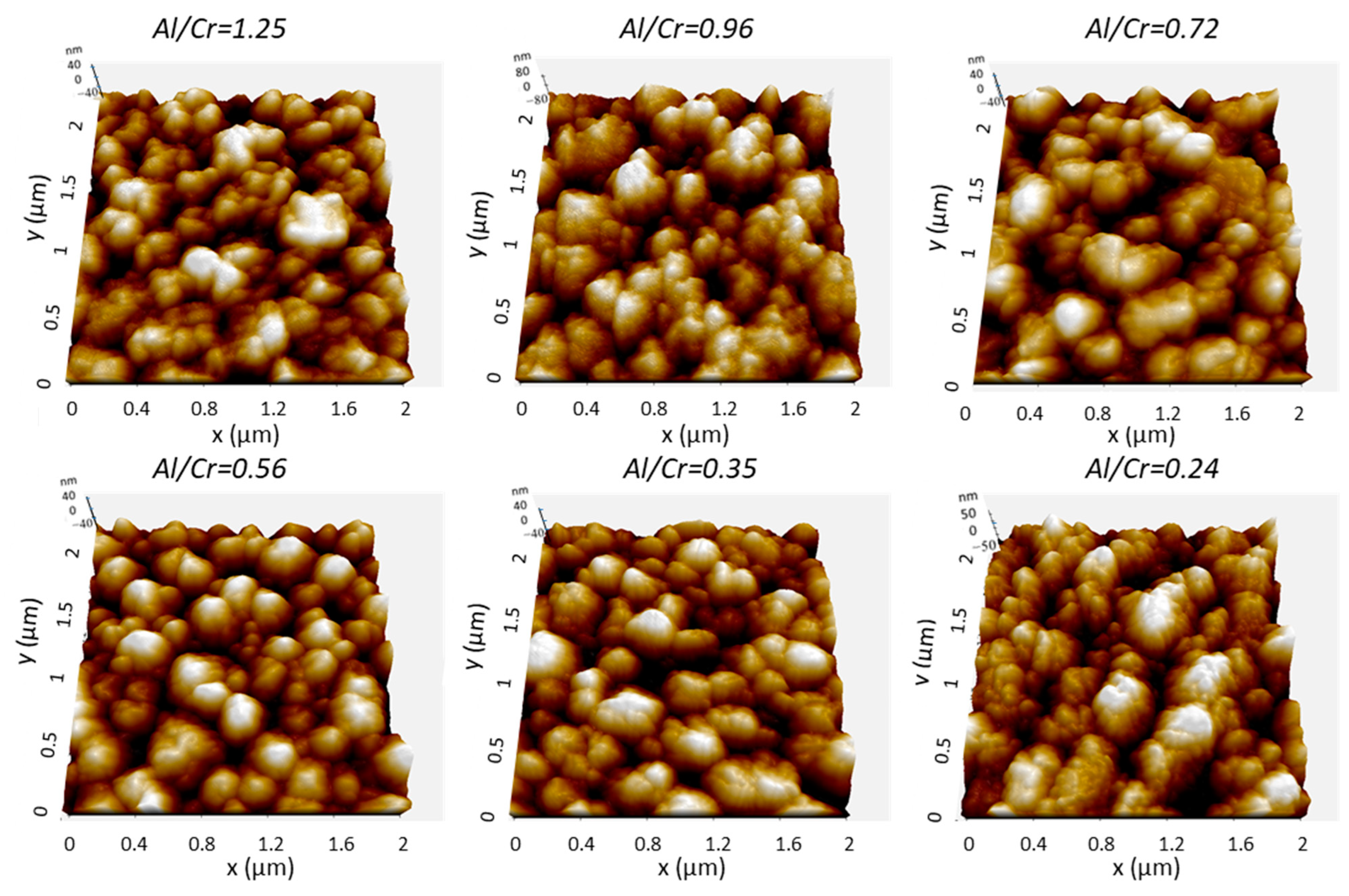

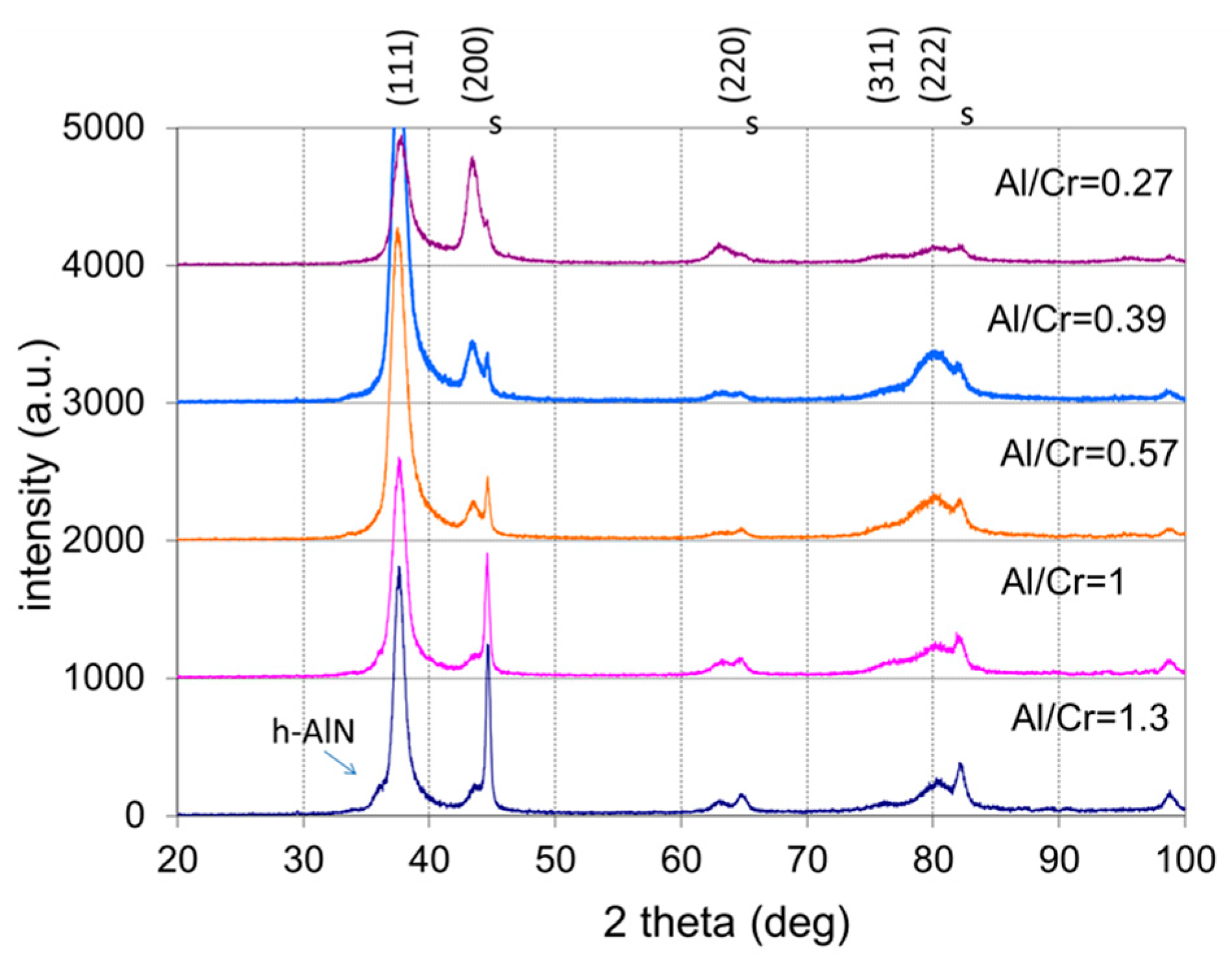
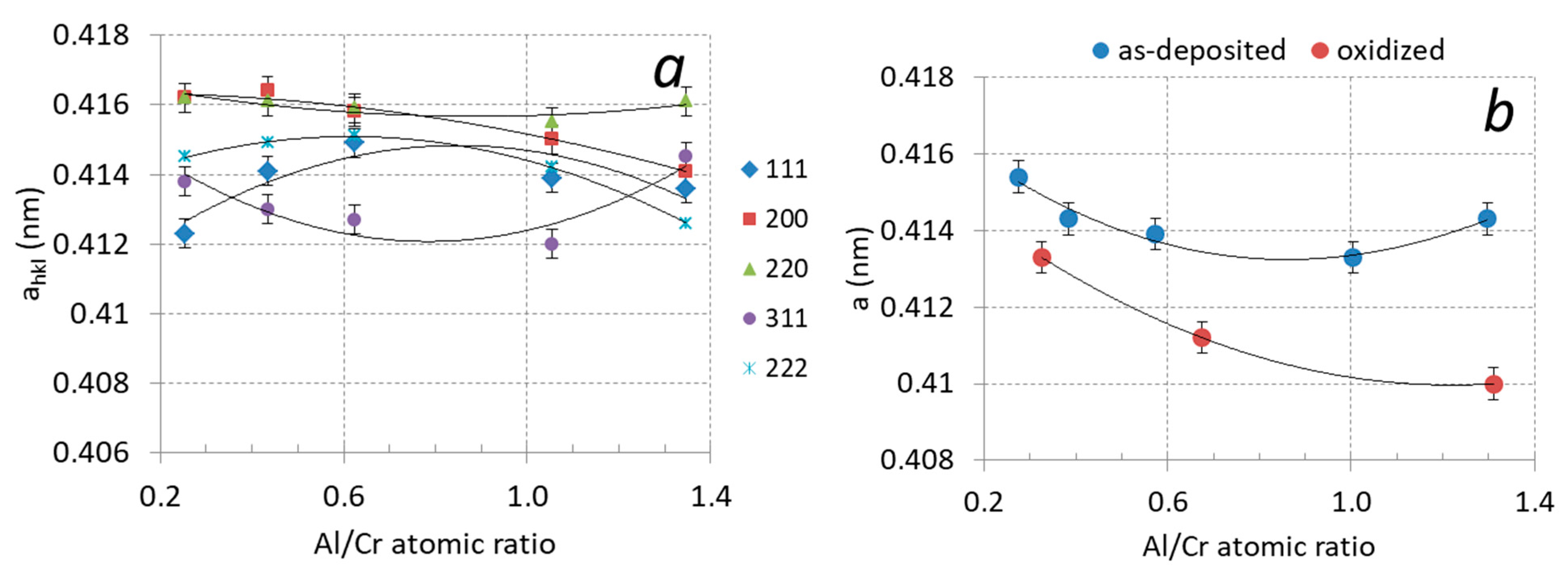
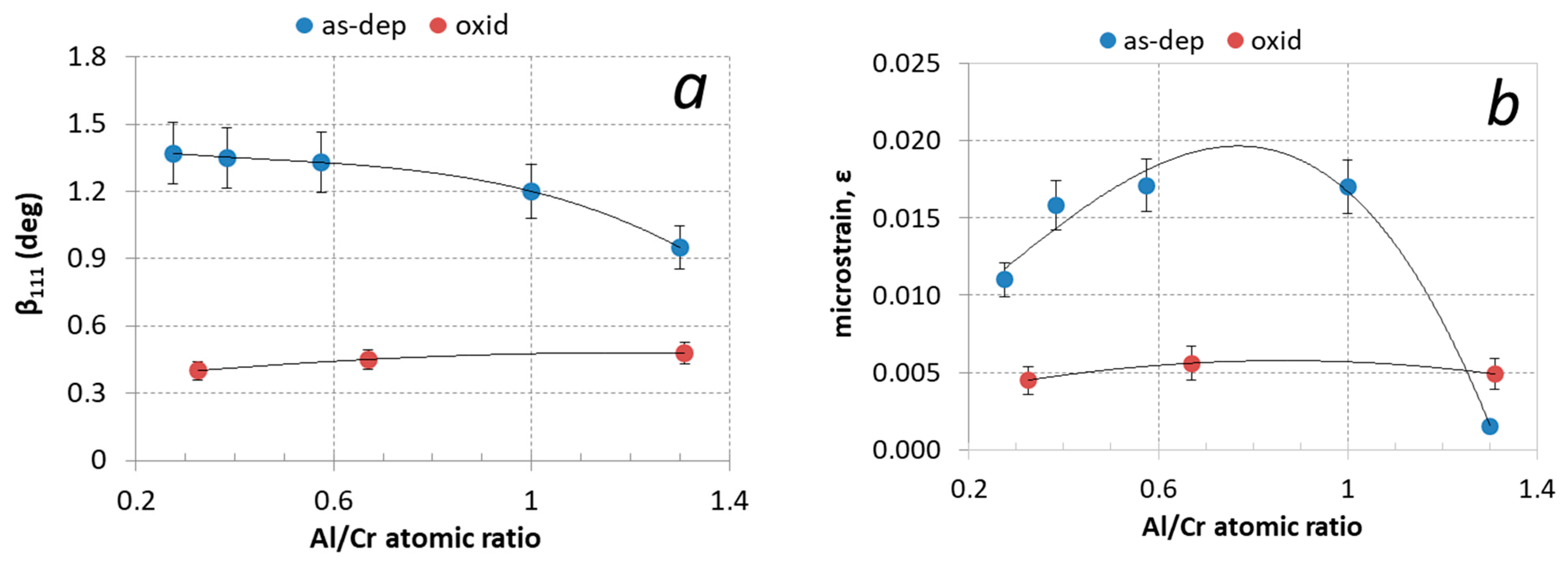
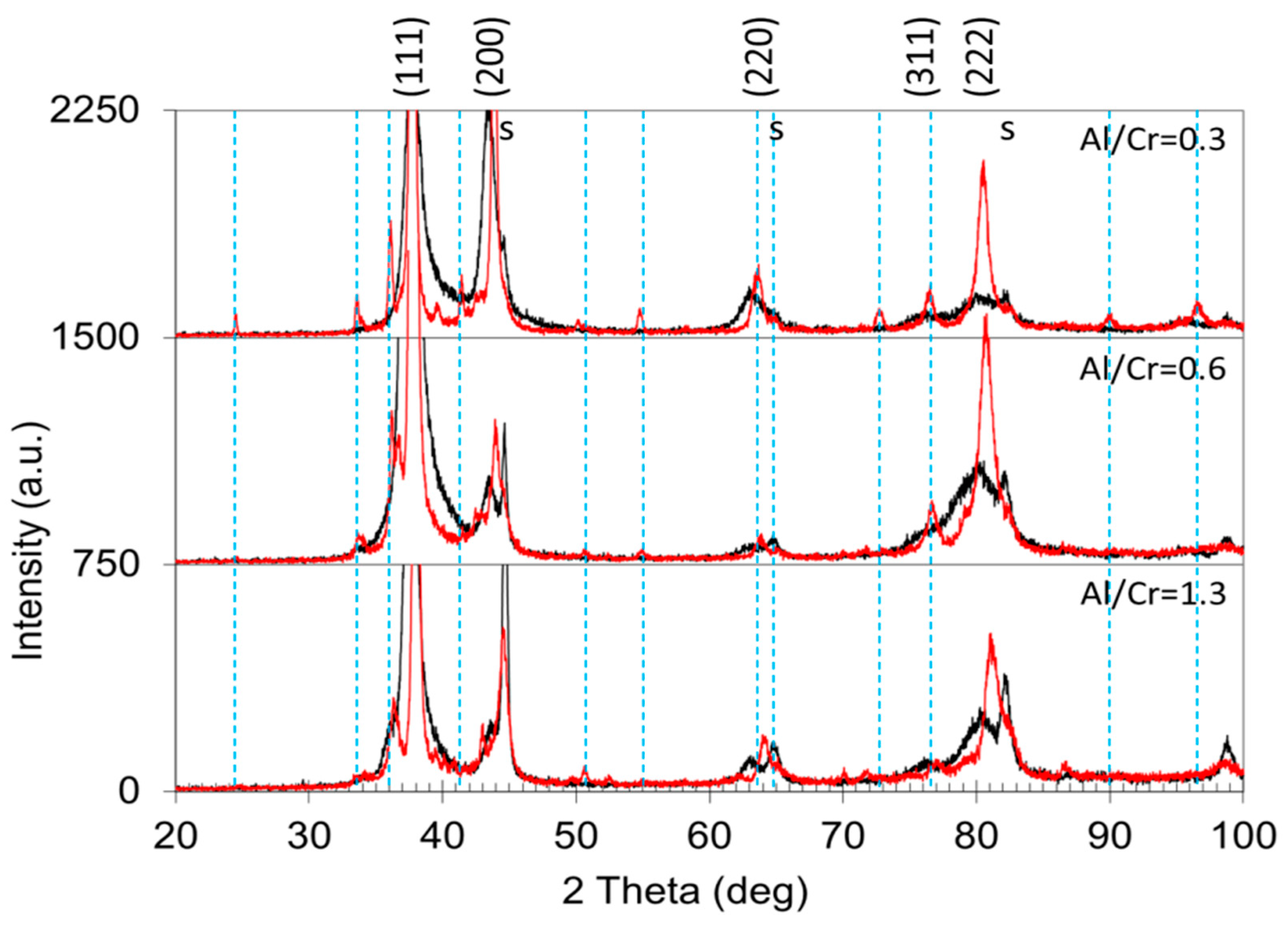

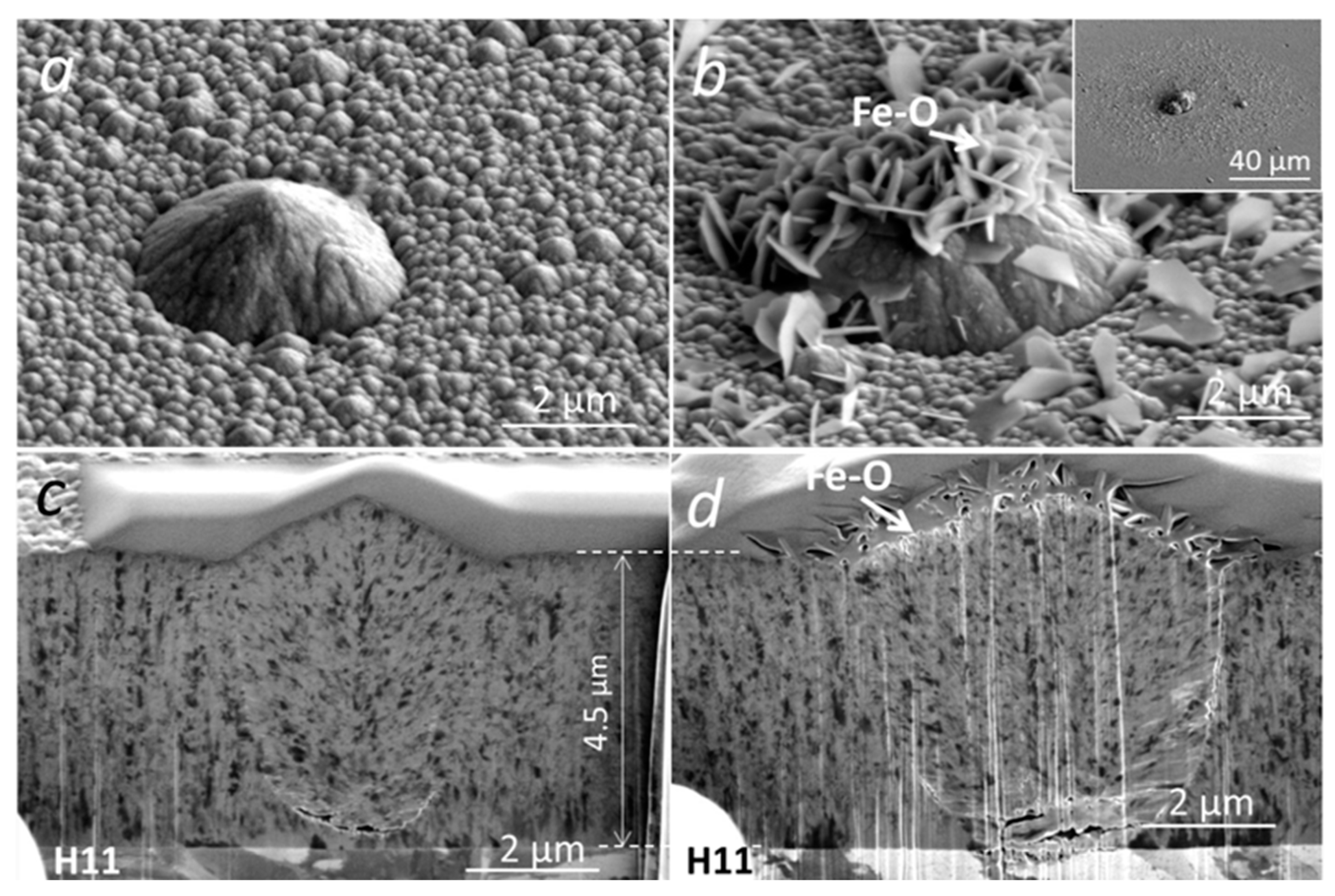
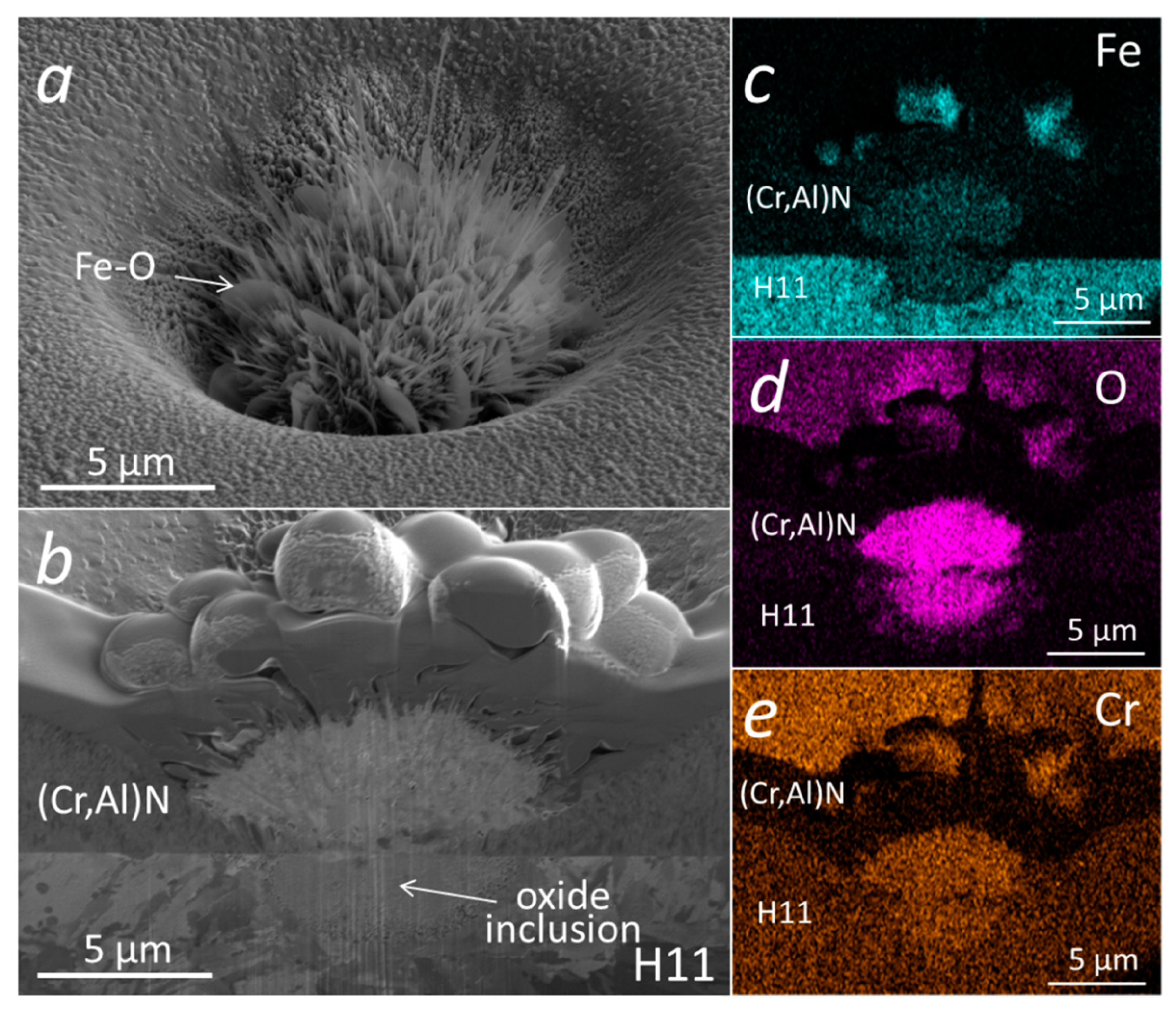

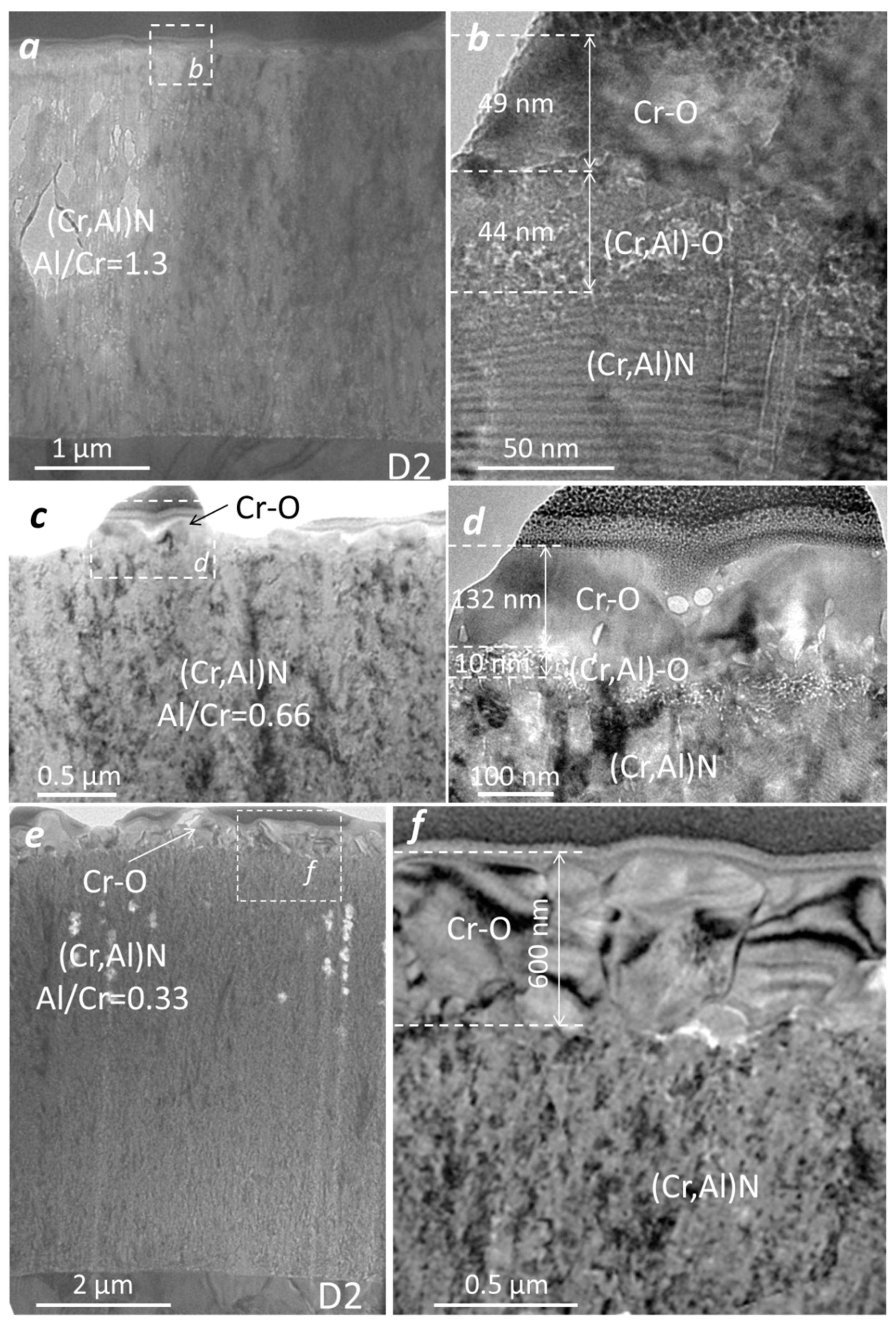
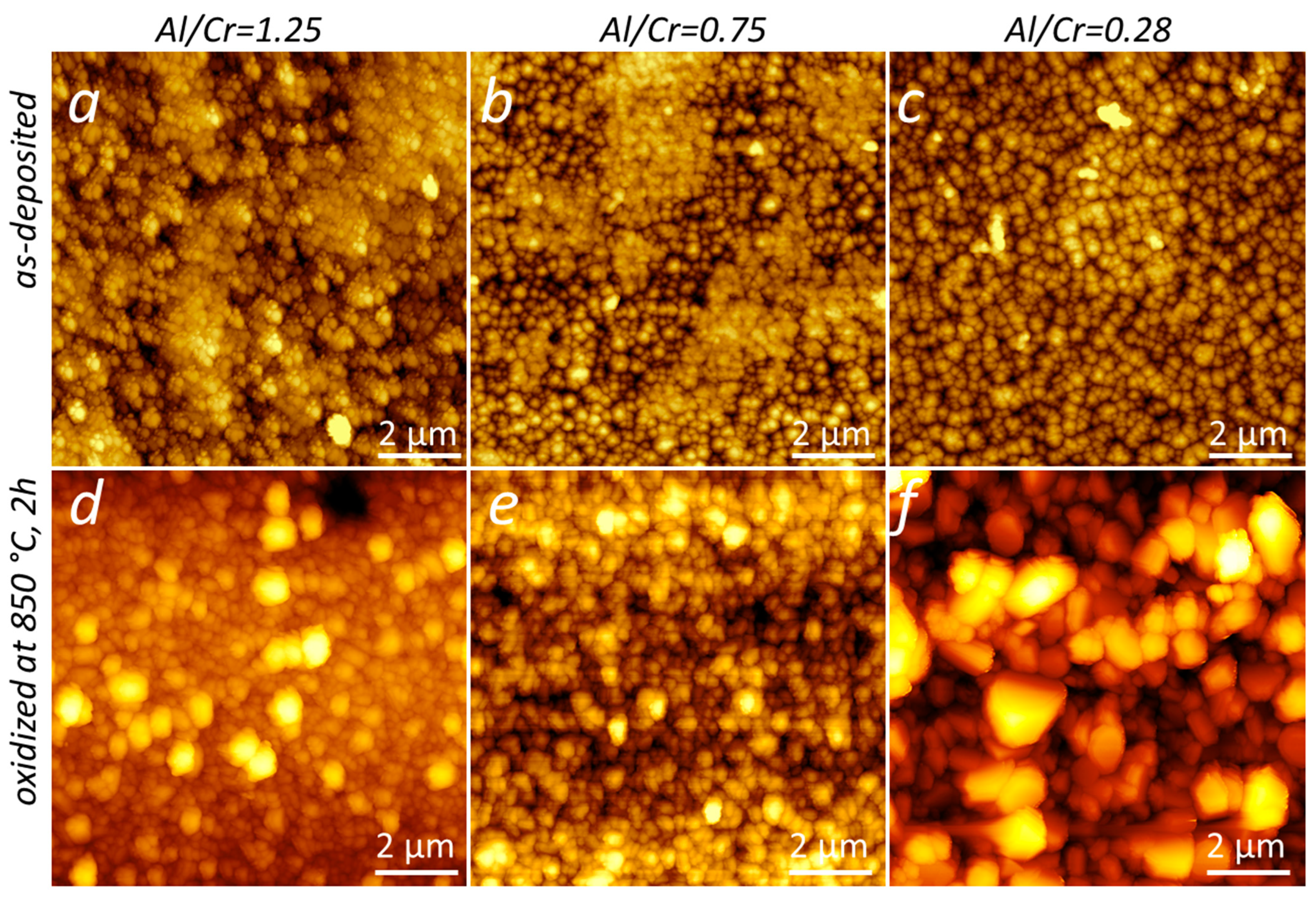
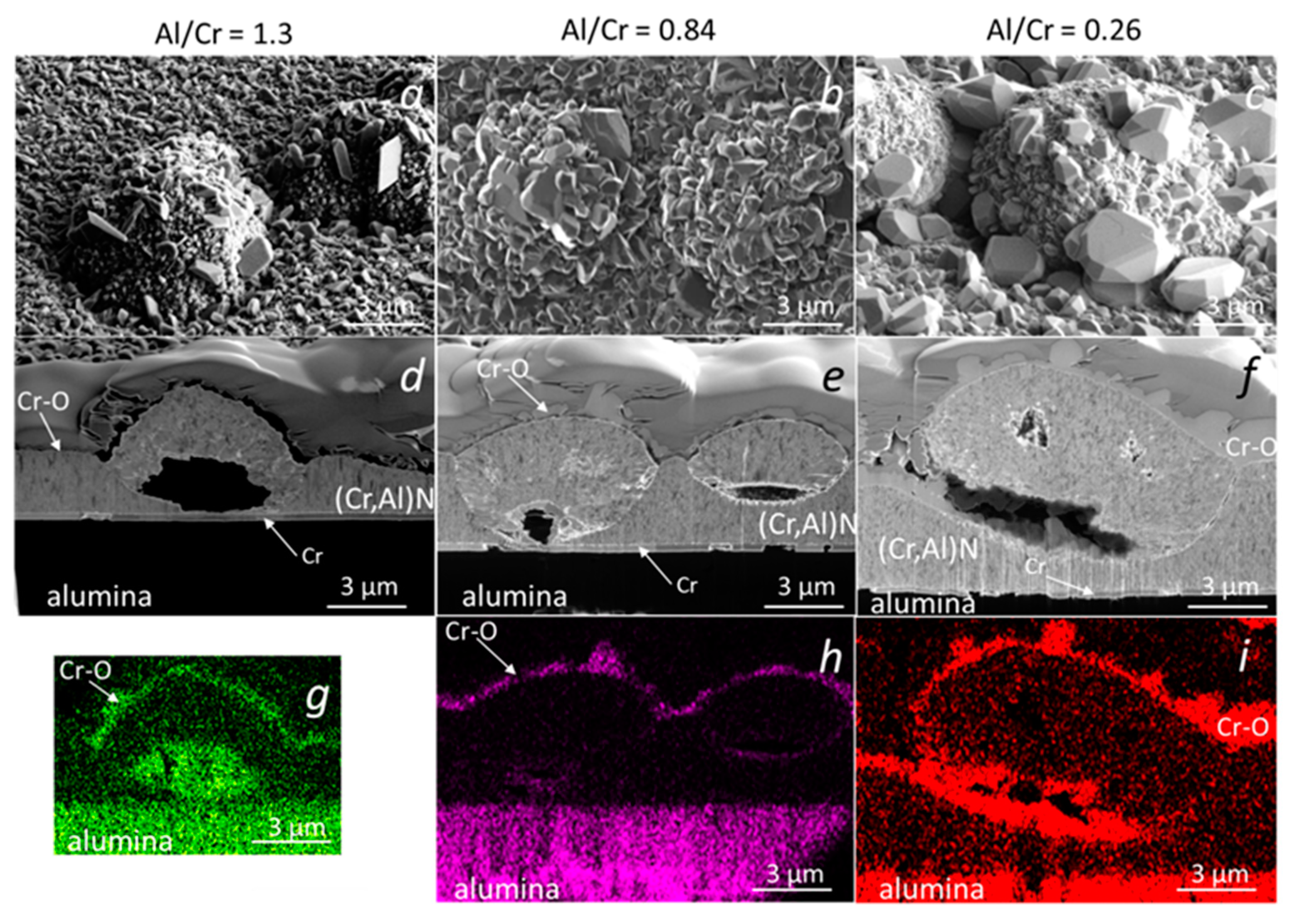
| Process Parameter | MF Etching | Deposition |
|---|---|---|
| Pressure (mPa) | 359 | 500 |
| Ar flow (sccm) | 150 | 200 |
| N2 flow (sccm) | - | 50 |
| Kr flow (sccm) | 50 | - |
| Frequency (kHz) | 240 | - |
| DC substrate bias (V) | 650 | 120 |
| Substrate table rotation speed (rpm) | 1 | 1 |
| Substrate temperature (°C) | 450 | 450 |
| Process time (min) | 45 | 240 |
| Power on the targets (W) | - | 2500 each |
| h | AlEDX | CrEDX | Al/Cr | t | tl | H | E | H/E | H3/E2 | Sa | β | a | ε |
|---|---|---|---|---|---|---|---|---|---|---|---|---|---|
| (cm) | (at. %) | (at. %) | (µm) | (nm) | (GPa) | (GPa) | (GPa) | (nm) | (°) | (nm) | |||
| 13 | 28.9 | 22.2 | 1.30 | 3.75 | 3.0 | 25.8 ± 1 | 276 | 0.093 | 0.225 | 20.8 ± 1 | 0.95 | 0.4143 | 0.0015 |
| 20 | 25.5 | 25.4 | 1.00 | 5.21 | 4.0 | 17.6 ± 1 | 271 | 0.065 | 0.074 | 24.4 ± 1 | 1.2 | 0.4133 | 0.0170 |
| 29 | 18.5 | 32.3 | 0.57 | 6.10 | 4.7 | 20 ± 1 | 275 | 0.072 | 0.105 | 24.9 ± 1 | 1.33 | 0.4139 | 0.0171 |
| 36 | 14.2 | 37.0 | 0.38 | 7.01 | 5.4 | 18.9 ± 1 | 241 | 0.079 | 0.117 | 23.5 ± 1 | 1.35 | 0.4143 | 0.0158 |
| 43 | 10.5 | 40.5 | 0.26 | 7.54 | 5.8 | 19.1 ± 0.5 | 259 | 0.074 | 0.104 | 20 ± 1 | 1.37 | 0.4154 | 0.0110 |
| Al/Cr | Ea | ko |
|---|---|---|
| (eV) | (µg2/cm4min) | |
| 0.32 | 1.81 | 9 × 1013 |
| 0.65 | 2.53 | 1 × 1012 |
| 1.3 | 3.06 | 7 × 109 |
Disclaimer/Publisher’s Note: The statements, opinions and data contained in all publications are solely those of the individual author(s) and contributor(s) and not of MDPI and/or the editor(s). MDPI and/or the editor(s) disclaim responsibility for any injury to people or property resulting from any ideas, methods, instructions or products referred to in the content. |
© 2023 by the authors. Licensee MDPI, Basel, Switzerland. This article is an open access article distributed under the terms and conditions of the Creative Commons Attribution (CC BY) license (https://creativecommons.org/licenses/by/4.0/).
Share and Cite
Drnovšek, A.; Kukuruzovič, D.; Terek, P.; Miletić, A.; Čekada, M.; Panjan, M.; Panjan, P. Microstructural, Mechanical and Oxidation Resistance of Nanolayer Sputter-Deposited CrAlN Hard Coatings. Coatings 2023, 13, 2096. https://doi.org/10.3390/coatings13122096
Drnovšek A, Kukuruzovič D, Terek P, Miletić A, Čekada M, Panjan M, Panjan P. Microstructural, Mechanical and Oxidation Resistance of Nanolayer Sputter-Deposited CrAlN Hard Coatings. Coatings. 2023; 13(12):2096. https://doi.org/10.3390/coatings13122096
Chicago/Turabian StyleDrnovšek, Aljaž, Dragan Kukuruzovič, Pal Terek, Aleksandar Miletić, Miha Čekada, Matjaž Panjan, and Peter Panjan. 2023. "Microstructural, Mechanical and Oxidation Resistance of Nanolayer Sputter-Deposited CrAlN Hard Coatings" Coatings 13, no. 12: 2096. https://doi.org/10.3390/coatings13122096






